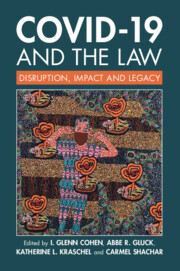COVID-19 has claimed over one million lives in the United States alone. The disease transcends race, class, gender, age, and religion, prompting many to refer to it as “the great equalizer.” The chapters in Part II of this volume debunk the “level playing field” myth and instead examine how the pandemic lays bare the social fault lines of our society. Each of these chapters delves into a discussion about how COVID-19 disproportionately impacts a specific historically marginalized community or population and exacerbates existing inequities while simultaneously giving rise to new ones.
In Chapter 6, “Tolerating the Harms of Detention: With and Without COVID-19,” Dr. Jaimie Meyer, Marisol Orihuela, and Judith Resnik examine the impact of COVID-19 on people in detention and locate the present moment within a historical movement for greater rights for prisoners. This chapter describes the poor spacing, lack of shared spaces and ventilation, and the scarcity of resources in prisons which give rise to “tinderbox situations” that lead to high rates of infections and clusters of outbreaks. It also discusses the legal and public health call for “dedensification” and critiques the institutional response to these demands as well as the limitations of the Eighth Amendment standard of “deliberate indifference to serious medical needs” in questioning conditions of confinement.
In Chapter 7, “A Bend Toward Greater Realized Health Equity and Racial Justice: How the Confluence of the COVID-19 Pandemic and Structural Racism Will Monumentally Shape American Law and Policy,” Scott Schweikart, Fernando De Maio, Mia Keeys, Joaquin Baca, Brian Vandenberg, and Dr. Aletha Maybank examine how the inequitable epidemiological burden of COVID-19 falls on Black, Indigenous, and People of Color communities in terms of tangible indicators such as mortality rates and life expectancy, as well as more ancillary indicators such as job loss and decline in employment income. This chapter demonstrates why such disparities cannot be attributed simply to preexisting conditions such as asthma and obesity; instead, a holistic examination of the impact of white supremacy and racism is warranted. Building on Abbe Gluck’s position that traditional health law should encompass public law that is defined by the role of the government, this chapter compellingly argues that factors such as structural racism are core areas of law related to the social and structural determinants of health, and further shows how nearly all areas of law could be deemed “health law” due to their impact on health equity.
Govind Persad and Jessica Roberts in Chapter 8, “Access to Vaccines and Critical Care Treatments for Older People and People with Disabilities,” take a more theoretical approach, outlining frameworks governing the formal allocation of critical care and vaccines in times of scarcity and exploring whether certain protocols and policies have the result of magnifying disadvantages for older Americans and people with disabilities. This chapter also discusses frameworks that could remediate disadvantages through intentional efforts, but goes on to describe how implementing such approaches could be made difficult due to barriers such as unconscious biases of health care providers and lack of transportation and technology, all of which make it hard for elderly people and people with disabilities to access care.
In Chapter 9, “Humane and Resilient Long-Term Care: A Post-COVID-19 Vision,” Nina Kohn details the devastating number of deaths and infections in long-term care facilities and, as does the chapter on incarceration, likens them to tinderboxes. This chapter attributes “preventable suffering” in long-term care facilities to public health failures, such as the lack of mandates for testing residents and staff, a limited supply of personal protective equipment, and a bumpy vaccine rollout. It also concretely identifies the lack of regulation and failure to implement existing regulations as problems made visible by COVID-19.
Each of these chapters reckons with the possibility that the pandemic “is a portal, a gateway between one world and the next,” as writer and political activist Arundhati Roy has described it. Chapter 6 on incarceration is less optimistic and exposes the tension between the heightened awareness of health risks to incarcerated populations and the state’s continuing appetite for mass incarceration and tolerance for debilitating modes of detention. In Chapter 7, on structural racism, the authors take a more optimistic view, finding that the pandemic’s legacy may include expanded health care access, criminal justice reform, and correction of historical redlining – each of which favorably impacts health equity. In Chapter 8, the authors put forth lessons learned from the pandemic, including the need for “debiasing” care and improving access to resources such as vaccines. Chapter 9, on long-term care, also focuses on what can be learned from the pandemic and outlines how financial incentives can be used to improve the quality of care.
Upon perusing these chapters, the reader will understand exactly why it is a mistake to think of the pandemic as an equalizer instead of a multiplier of inequities. That said, the purpose of these chapters is not to encourage despair, but to foster calls to action and make tangible legal and policy recommendations. It is powerful that these authors see this pandemic as an inflection point for more than mere superstructural changes to the policy framework, and intentionally identify deeper issues, such as mass incarceration, racism, ableism, and the lack of community-based care, as impeding us from creating a safer, healthier, and more equitable future for our society’s most vulnerable people.



